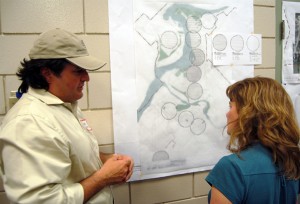
By David F. Rooney
Like a lot of people, Mayor David Raven was a little ambivalent about the City’s move to embrace SmartCode development standards through the Unified Development Bylaw.
He was familiar with the traditional zoning structure so why change? After all, if it isn’t broke why fix it?
“I’m just naturally cautious,” he said as he examined some of the displays at Thursday’s evening public charrette at the Community Centre.

But over the course of this week, Raven’s cautious approach has warmed up to the point that he sees the value of a new kind of zoning that regards neighbourhoods as being more just a collection of dwellings lined up on roads for large, noisy and smelly machines.
He’s not alone. Many of the more than 60 people who attended the evening meeting are excited about the possibilities inherent in the SmartCode, even if they still haven’t completely wrapped their heads around the fact that it will make Revelstoke more liveable and it will ensure that new development fits in with the community’s vision of itself as a green, human-scaled urban environment.
“I have no problem with change — as long as it’s positive,” said Arrow Heights resident Chuck Purse. “I just don’t want to wake up one morning and find there’s a 7-11 a block away.”
“Change — as long as it’s positive” — there’s the rub. Since he bought his home on Nichol Road 25 years ago, Purse has seen the roadway go from being a suburban artery to a busy quasi-highway. There’s a change for you and it’s one he and his wife are very aware of, especially since she was, he said, almost killed turning off Nichol into their driveway by a driver who decided to use that moment to try and pass her.
The traffic growth on Nichol is a natural consequence of the ski hill development and is a concern for many people in the area. However, under the existing zoning there’s not much that can be done about. Whether the UDB can alter that remains to be seen, but it may give neighbourhoods some power over their local development that they wouldn’t otherwise have.
This approach, often referred to as Smart Growth or SmartCode (To get more background info and to download the latest versions of the model SmartCode, go here.) or as “form-based planning” encourages planning based on the type of environment. For instance, instead of the standard zones such as R1, R2, etc., form-based planning encompasses an environmental spectrum of so-called Transects from a fully natural zone, referred to as T1, to T6, which is a high-density residential and commercial neighbourhood in the urban core of a city. The interesting thing about these so-called Transects is that they recommend development that is people-friendly and decidedly Green. (To see a full description of the Transects, please go here.)
John Devitt, executive director of the Chamber of Commerce, is fairly impressed by the SmartCode’s potential to maintain a human-scale urban environment.
“I like the process and find it useful and the concept sound, but it will still require political will to make it work,” he said.
Hence the charrette. This week-long process engages members of the community and helps them better understand how a SmartCode can improve their quality of life over time. As their understanding becomes clearer it becomes less likely that the public will resist its implementation through the UDB.
So, will we be using SmartCode at this same time next year?
Raven said he recognizes it will take some political will power to effect this kind of change and while he thinks the first few times it is implemented the results may be a little wonky, “by the fourth time we’ll have it down pat.”
The charrette process ends Friday, June 11, with a 90-minute closing presentation at the Community Centre and additional opportunity for public comment. PlaceMakers intends to deliver a first draft of the SmartCode-based Unified Development Bylaw by Aug. 6. A public hearing on the bylaw is slated to be held sometime in September or early October with a delivery date of Oct. 15 for the final version of the UDB.
To find out more about the UDB and the PlaceMakers team please go to www.revelstokeudb.com. Comments and questions you post on the site will be answered promptly. There are also videos on the website that make for interesting viewing.



